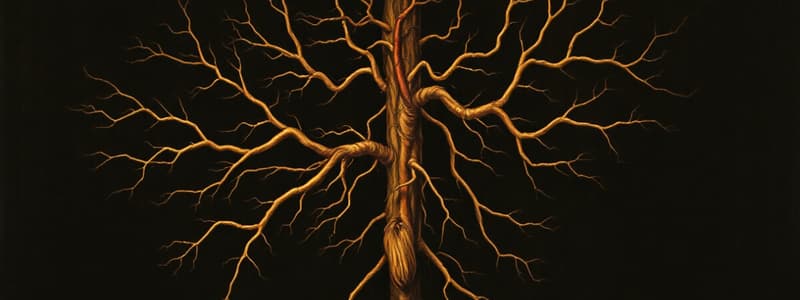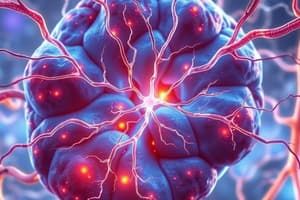Podcast
Questions and Answers
What is the structural unit of nervous tissue?
What is the structural unit of nervous tissue?
Neurons or Nerve Cells
What is the origin of nervous tissue?
What is the origin of nervous tissue?
Ectoderm
What are the two main divisions of the nervous system?
What are the two main divisions of the nervous system?
Central Nervous System (CNS) and Peripheral Nervous System (PNS)
Which of the following are components of nervous tissue? (Select all that apply)
Which of the following are components of nervous tissue? (Select all that apply)
Neurons are capable of undergoing mitosis.
Neurons are capable of undergoing mitosis.
What are the three types of neurons categorized by their function?
What are the three types of neurons categorized by their function?
What are the four main types of neuroglia found in the CNS?
What are the four main types of neuroglia found in the CNS?
What are two key functions of astrocytes in the CNS?
What are two key functions of astrocytes in the CNS?
What is the primary function of oligodendrocytes in the CNS?
What is the primary function of oligodendrocytes in the CNS?
What is the main function of microglia in the CNS?
What is the main function of microglia in the CNS?
What is the primary function of ependymal cells in the CNS?
What is the primary function of ependymal cells in the CNS?
What is the main function of Schwann cells in the PNS?
What is the main function of Schwann cells in the PNS?
What two things comprise a nerve fiber?
What two things comprise a nerve fiber?
Myelin is a non-lipid substance.
Myelin is a non-lipid substance.
What is the process of myelin formation called?
What is the process of myelin formation called?
What are the gaps between myelin sheaths along an axon called?
What are the gaps between myelin sheaths along an axon called?
Which of the following are components of gray matter in the CNS? (Select all that apply)
Which of the following are components of gray matter in the CNS? (Select all that apply)
The spinal cord has a central canal containing white matter.
The spinal cord has a central canal containing white matter.
The cerebellum has an outer layer of grey matter and inner layer of white matter.
The cerebellum has an outer layer of grey matter and inner layer of white matter.
What are the three meninges that cover the brain and spinal cord?
What are the three meninges that cover the brain and spinal cord?
What is the name of the tangled network of axons, dendrites, and neuroglial processes in the CNS?
What is the name of the tangled network of axons, dendrites, and neuroglial processes in the CNS?
What is the role of sensory receptors in the peripheral nervous system?
What is the role of sensory receptors in the peripheral nervous system?
Taste receptors are mechanoreceptors.
Taste receptors are mechanoreceptors.
Touch receptors only detect pressure.
Touch receptors only detect pressure.
Which of the following is NOT one of the five senses?
Which of the following is NOT one of the five senses?
What are the specialized cells in the olfactory epithelium that detect smells?
What are the specialized cells in the olfactory epithelium that detect smells?
Flashcards
Nervous tissue
Nervous tissue
A type of tissue responsible for receiving, processing, and transmitting information throughout the body.
Neuron
Neuron
The functional unit of the nervous system, responsible for transmitting electrical signals.
Neuroglial cells
Neuroglial cells
Support cells that provide structural and metabolic support to neurons in the nervous system.
Central nervous system (CNS)
Central nervous system (CNS)
Signup and view all the flashcards
Peripheral nervous system (PNS)
Peripheral nervous system (PNS)
Signup and view all the flashcards
Soma
Soma
Signup and view all the flashcards
Dendrites
Dendrites
Signup and view all the flashcards
Axon
Axon
Signup and view all the flashcards
Synapses
Synapses
Signup and view all the flashcards
Synaptic cleft
Synaptic cleft
Signup and view all the flashcards
Presynaptic cell
Presynaptic cell
Signup and view all the flashcards
Postsynaptic cell
Postsynaptic cell
Signup and view all the flashcards
Neurotransmitters
Neurotransmitters
Signup and view all the flashcards
Nerve impulse conduction
Nerve impulse conduction
Signup and view all the flashcards
Myelin sheath
Myelin sheath
Signup and view all the flashcards
Myelination
Myelination
Signup and view all the flashcards
Astrocytes
Astrocytes
Signup and view all the flashcards
Oligodendrocytes
Oligodendrocytes
Signup and view all the flashcards
Microglia
Microglia
Signup and view all the flashcards
Ependymal cells
Ependymal cells
Signup and view all the flashcards
Satellite cells
Satellite cells
Signup and view all the flashcards
Schwann cells
Schwann cells
Signup and view all the flashcards
Nerves
Nerves
Signup and view all the flashcards
Ganglia
Ganglia
Signup and view all the flashcards
Sensory receptors
Sensory receptors
Signup and view all the flashcards
Mechanoreceptors
Mechanoreceptors
Signup and view all the flashcards
Thermoreceptors
Thermoreceptors
Signup and view all the flashcards
Nociceptors
Nociceptors
Signup and view all the flashcards
Photoreceptors
Photoreceptors
Signup and view all the flashcards
Chemoreceptors
Chemoreceptors
Signup and view all the flashcards
Proprioceptors
Proprioceptors
Signup and view all the flashcards
Study Notes
Nervous Tissue
- Nervous tissue is a communication network in the body, responsible for controlling and integrating body functions within limits that maintain life.
- It's composed of closely associated cells that perform related functions.
- There are four main types of tissue: nervous, epithelial, muscle, connective.
- Nervous tissue originates from ectoderm.
Learning Objectives
- Understand the general characteristics of nervous tissue.
- Identify the components of nervous tissue.
- Identify central nervous system (CNS) organs.
- Identify peripheral nervous system (PNS) organs.
Divisions of Nervous System
- Nervous system is divided into central (CNS) and peripheral (PNS).
- CNS includes the brain and spinal cord.
- PNS includes cranial nerves, spinal nerves, and ganglia.
- The PNS further splits into somatic and autonomic nervous systems. Somatic controls voluntary movement. Autonomic controls involuntary processes (e.g., heart rate). Autonomic further divides into sympathetic (activating) and parasympathetic (calming).
General Organization
- CNS includes the brain and spinal cord.
- PNS includes cranial, spinal nerves, and ganglia.
- Histology of CNS: neurons, astrocytes, oligodendrocytes, microglial cells, ependymal cells. Histology of PNS: Neurons, satellite cells, Schwann cells.
- CNS tissue contains neurons and neuroglial cells (supportive, non-transmitting). PNS contains neurons and supporting neuroglial cells, involved in protection, nutrition, and structure support.
Neurons or Nerve Cells
- Structural unit of nervous tissue.
- Conducts impulses.
- Characteristics: longevity, amitotic, high metabolic rate (requiring O2 and glucose).
- Structure: cell body, perikaryon or soma, processes or neurites. The cell body is the metabolic center of the neuron.
- Cell body contains, Golgi apparatus, Rough ER (Nissl bodies), smooth ER, mitochondria, and other cellular components (cytoplasmic inclusions).
- Processes or neurites extend from the cell body include dendrites (receive stimuli) and axons (transmit impulses).
Cell Body
- Plasma membrane: receives stimuli, integrates them, and generates nerve impulses, contains ion channels and the Na+-K+ pump.
- Cytoplasm: contains Nissl bodies (rough endoplasmic reticulum), Golgi apparatus, mitochondria.
Processes or Neurites
- Dendrites: short, branched extensions that receive stimuli from other nerve cells, many, branched, irregularly shaped.
- Axon: single long extension that transmits impulses to other neurons or effector cells, uniform diameter, branched at their ends (forming synaptic knobs) with neurotransmitters, no Nissl's granules.
Classification of Neuron
- Function: sensory (afferent), interneurons, motor (efferent).
- Number of processes: unipolar, bipolar, pseudounipolar, multipolar.
Synapses
- Functional connection between a nerve fiber and a target cell.
- Types: chemical, electrical. Chemical synapses are unidirectional and utilize neurotransmitters to signal. Electrical synapses provide direct electrical coupling.
Neuroglial Cells
- 10 times more numerous than neurons in the nervous system.
- Support, nourish, and protect neurons.
- Types in CNS: astrocytes, oligodendrocytes, microglia, ependymal cells.
- Types in PNS: satellite cells, Schwann cells.
Astrocytes
- Star-shaped, abundant cytoplasm with intermediate filaments (GFAP)
- Processes contact blood vessels and neurons.
- Functions: maintain blood-brain barrier, regulate tissue fluid composition, structural support and organization, stimulate scar tissue formation.
Oligodendrocytes
- Smaller than astrocytes, fewer processes.
- Form myelin sheaths in the CNS.
Microglia
- Smallest glial cells, originate from monocytes.
- Phagocytic functions in the CNS for defense and debris removal.
Ependymal Cells
- Low columnar or cuboidal epithelial cells.
- Line ventricles of the brain and central canal of the spinal cord.
- Form cerebrospinal fluid, facilitate its movement.
Satellite Cells
- Small, round, spindle-shaped cells, surround neuron cell bodies in ganglia of PNS.
- Functions: protect cell bodies, regulate nutrient supply for cell bodies.
Schwann Cells
- Flattened cells, encase axons of peripheral nerves with a membrane.
- Myelinate PNS axons
- Allow faster nerve impulse conduction.
Nerve Fibers
- Myelinated: enclosed in a myelin sheath for faster conduction.
- Unmyelinated: no myelin sheath.
Myelin Sheath
- Composed of phospholipids, glycolipids and cholesterol
- Function: insulates the axons, increases speed of nerve impulses.
Myelination
- Invagination of a single nerve axon into a Schwann cell forms myelin sheath.
Organization of Nervous Tissue in CNS
- Grey matter: soma, dendrites, unmyelinated fibers, glial cells.
- White matter: axons, myelinated fibers, network of neural tissue.
- Meninges (connective tissue): dura mater, arachnoid mater, pia mater.
Spinal Cord
- Ventral horns: motor neurons.
- Dorsal horns: sensory neurons.
Cerebellum
- Grey matter comprises the cortex, white matter comprises the medulla.
Organization of Nervous Tissue in PNS
- Consists of peripheral nerves, ganglia, and sensory receptors.
Peripheral Nerves
- Nerve fibers bundled together into elongated fascicles.
- Includes epineurium, perineurium, endoneurium.
Peripheral Nerve Regeneration
- Stages: injury, chromatolysis, atrophy, scarring, successful/unsuccessful regeneration.
Ganglia
- Associated with cranial nerves (pseudounipolar cell bodies).
- Multipolar neurons.
Sensory Receptors
- Receptors detect stimuli.
- Types: mechanoreceptors (touch, hearing), thermoreceptors (temperature), nociceptors (pain), photoreceptors (light), chemoreceptors (smell, taste).
- Classification based on stimulus source (exteroceptors, interoceptors, proprioceptors).
- Senses: vision, hearing, smell, taste, touch.
Studying That Suits You
Use AI to generate personalized quizzes and flashcards to suit your learning preferences.




